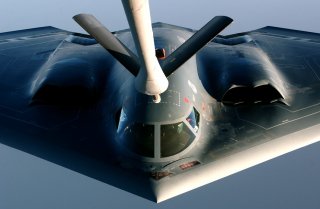How the Air Force's 30-Year-Old B-2 Stealth Bomber Looks on the Inside
Despite flying more than 40-hour missions, pilots have no bed and no refrigerator, just two seats in a small cockpit and a small area behind them about the same width as the seat.
The priority, maintainers explain, is to ensure the weapons, electronics, computing and stealth properties are all continuously upgraded. Today’s B-2 could almost be described, in some ways, as an entirely different airplane with the same basic exterior - than it was upon first flight in 1989.
The Air Force currently operates 20 B-2 bombers, with the majority of them based at Whiteman AFB in Missouri. The B-2 can reach altitudes of 50,000 feet and carry 40,000 pounds of payload, including both conventional and nuclear weapons.
One emerging nuclear weapon, now being tested and integrated onto the B-2 is the advanced B-61 Mod 12, an upgraded variant of several different nuclear bombs with integrates their functionality into one weapon. This not only decreases payload but of course multiplies attack options for pilots. For instance, a B-2 could quickly adjust from a point detonate variant of the B-61 Mod 12, to one designed with penetration capabilities, Air Force officials said. Alongside its nuclear arsenal, the B-2 will carry a wide range of conventional weapons to include precision-guided 2,000-pound Joint Direct Attack Munitions, or JDAMs, 5,000-pound JDAMs, Joint Standoff Weapons, Joint Air-to-Surface Standoff Missiles and GBU 28 5,000-pound bunker buster weapons, among others. The B-2 can also carry a 30,000-pound conventional bomb known as the Massive Ordnance Penetrator, a weapon described as a more explosive version of the Air Force GBU-28 bunker buster.
The platform is also preparing to integrate a long-range conventional air-to-ground standoff weapon called the JASSM-ER, for Joint Air-to-Surface Standoff Missile, Extended Range.
Despite flying more than 40-hour missions, pilots have no bed and no refrigerator, just two seats in a small cockpit and a small area behind them about the same width as the seat. Pilot’s food, Polidar said, needs to be non-perishable items.
“Sometimes we can bring a little blow-up mattress, put in on the floor and take a nap,” she said.
So how much longer will the B-2 fly? It is slated to fly alongside the emerging new B-21 Raider stealth bomber as it starts arriving in the mid 2020s, and ultimately retire. However, given its current trajectory and combat effectiveness, it seems entirely reasonable to speculate 2040? Perhaps 2050? We’ll see, the Air Force does not discuss this much.
Osborn previously served at the Pentagon as a Highly Qualified Expert with the Office of the Assistant Secretary of the Army - Acquisition, Logistics & Technology. Osborn has also worked as an anchor and on-air military specialist at national TV networks. He has a Masters Degree in Comparative Literature from Columbia University.
This piece first appeared in 2019 and is being reprinted due to reader interest.

